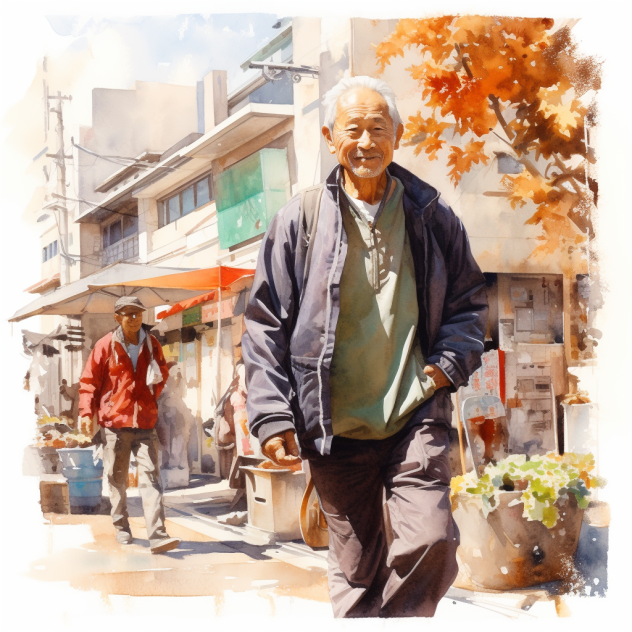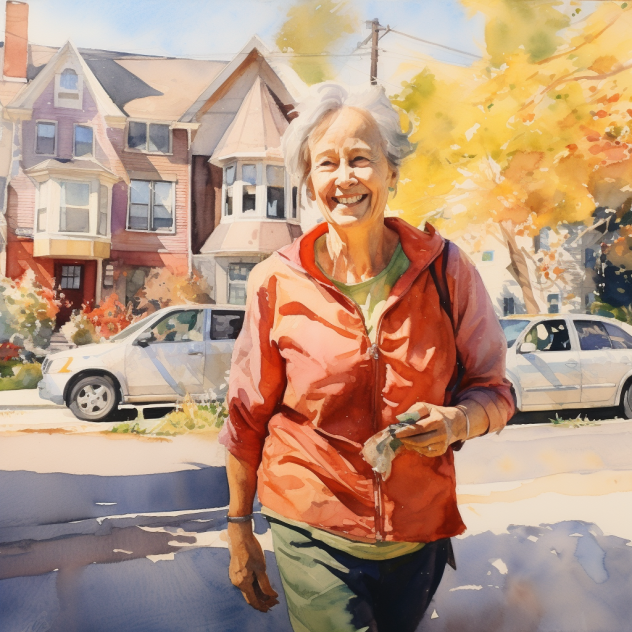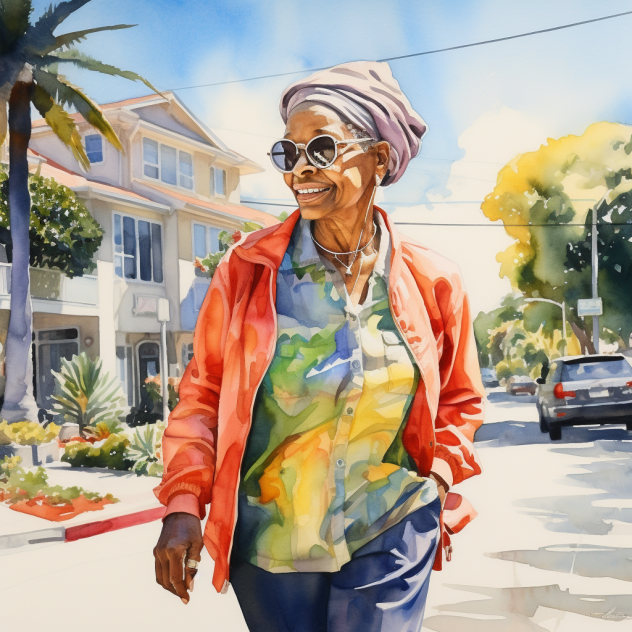Audience: Olders to Elders - SoloAgers
- Empty Nesters - Continuing Educators
- Professionals - Retired Creators
- Grandparents - Younger-Older-Mentors
- and YOU!
Olders to Elders Experiencing Psychosocial Safety Within-Without
This passage from "olders" to "elders" signifies a profound shift, transcending mere chronology. It's a journey of accumulating wisdom, experiences, and a deepening understanding of oneself and the world.
At the heart of this journey lies psychosocial safety, a dynamic interplay between internal well-being and the external well-living that shapes a person’s quality of life as they navigate their involvement with (Solo)Aging --- Older to Elder!
Moving In:
This wholistic psychosocial safety awareness, the decisions required, represent more than just a shift in age; they signify a shift in mindset and perspective. It's about cultivating a sense of inner peace, emotional resilience, and a feeling of security in one's identity and relationships.
This article explores the meaning and action-outcomes aligned with improving, focusing, and strengthening wholistic psychosocial safety in daily activities for your unique journey and adventures with others.
Broad Brush Explanation of Wholistic Psychosocial Safety Approach
The wholistic psycho-social safety approach integrates principles of both wholistic and psychosocial safety perspectives to promote well-being, well-living, and safety in various settings, whether personal places and spaces, places of work, and/or communities.
Holistic Approach:
The holistic aspect emphasizes the interconnectedness of different aspects of well-being, including physical, mental//emotional, soulful, spiritual, and social dimensions. It recognizes that persons are dynamic beings influenced by multiple factors, and their overall well-being//well-living depends on addressing all these aspects in an integrated manner.
Psychosocial Safety:
Psychosocial safety refers to creating all places and spaces that protect persons’ psychological health and fosters optimistic social interactions. It involves managing foreground and background stressors, promoting supportive relationships, and ensuring fair and just collaborative conversations.
Integration:
The wholistic psychosocial safety concepts and practices integrate as an approach to create situations (ecosystems) that support the overall wellth (wealth and health mix) of persons while also ensuring their personal and shared psychological safety.
5 Pillars Of A Wholistic Psychosocial Safety Approach For Older To Elders
Physical Health and Safety:
Ensure access to healthcare services, promote healthy lifestyle habits, and create safe living situations to support physical well-being. This includes addressing issues such as mobility, nutrition, medication management, and fall prevention.
Mental Health Support:
Provide resources and services to address mental health concerns and promote emotional well-being. This may involve offering counseling or therapy services, facilitating support groups, and promoting activities that reduce stress and enhance resilience.
Social Connection and Engagement:
Foster social connections and meaningful engagement to deal with loneliness and isolation. Encourage participation in social activities, community events, and volunteer opportunities to promote a sense of belonging and purpose.
Financial Security:
Address financial concerns and promote economic stability to reduce stress and anxiety related to financial insecurity. Provide access to resources and information on financial planning, retirement savings, and government support programs.
Environmental Adeption(1) (Adoption//Adaption):
Create age-friendly places and spaces that accommodate the changing needs of older adults and elders. This may include accessibility modifications, providing assistive devices and technologies, and promoting age-inclusive policies and practices in various settings.
Manage Safe Systems For Persons Through A Wholistic Psychosocial Safety Approach
"Manage safe systems for persons" refers to a comprehensive method of considering various interconnected factors that influence a person’s physical, mental//emotional, soulful, spiritual, and wholversical requirements and requests including social and community interactions.
It involves implementing systems//processes framed by inspired concepts and wise practices that address the broader//narrower context in which persons live and interact, aiming to create situations that support their overall wellth movement.
Therefore, managing safe systems involves developing initiatives that address the following factors wholistically, contributing to a person's overall quality of living (legacy):
_ mental//emotional health (well-being) support
_ social (well-living) support
_ community engagement
_ access to resources including technology
_ policies and practices for places of work
_ policies and practices for community involvement
Lead Persons From Safer Practices Through A Wholistic Psychosocial Safety Approach
"Lead persons from safer practices’ entails guiding persons towards adopting/adapting activities and behaviors that contribute to their overall safety wholistically.
Leading persons from safer practices involve actively promoting and facilitating safety enhancements to mitigate risks across various aspects of their lives like adopt healthy lifestyle habits, fostering supportive social connections, and creating places and spaces that prioritize safety through well-being and well-living lenses.
A selection of safer practices:
_*_ address the interconnectedness of proactive//generative factors that influence safety and well-being//well-living.
_*_ use multifaceted strategies and tactics to move your unique journey forward as you adventure together with others
_*_ encourage making informed decisions, accessing support and resources to facilitate wellthy living behaviors and outcomes.
5 Considerations ReFraining Your Safety Approach
When using a wholistic psychosocial safety approach for olders to elders, here are five considerations worth taking into accountability NOW!
// Focus Of Safety Awareness Is Intention And Attention
// The Importance of Valuing Safety
// Felt Organization of Living Life Safely
// My Role in Safety
// Sustaining Safety: Safe Systems and Safer Practices
Focus Of Safety Awareness Is Intention And Attention:
This concept emphasizes that safety awareness involves both intention and attention. Intention refers to the deliberate desire or aim to prioritize safety in your actions and decisions. Attention refers to the mindfulness and awareness of potential risks and hazards in your space/place through ecosystem//environment.
By focusing on both intention (the desire for safety) and attention (being mindful of safety-related factors), you can cultivate a safety-conscious mindset and take measures to mitigate risks.
The Importance of Valuing Safety:
This highlights the significance of recognizing and valuing safety as a fundamental aspect of well-being. When you prioritize safety, you acknowledge its importance in preserving your health (and wealth), protecting yourself from harm, and promoting overall quality of life.
Valuing safety involves considering safety concerns in various aspects of your life, making informed decisions to minimize risks, and actively seeking to create safe situations for self and with others.
Felt Organization of Living Life Safely:
This concept refers to your experiences of how to organize your life to prioritize safety.
It recognizes that you may have unique ways of structuring your routines, environments, and behaviors to enhance your sense of safety and security.
The "felt organization" aspect highlights the personal and emotional dimension of safety, where your feelings play a significant role in shaping your safety practices and behaviors.
My Role in Safety:
Your responsibility and agency in contributing to your own safety and the safety of those around them is as important as the air you breathe.
It underscores the idea that safety is not solely the responsibility of external authorities or systems. They help! It requires your active participation and engagement (often with others who walk with you).
By recognizing your role in safety, you can take ownership of your actions, make informed decisions, and contribute to creating safer environments for all involved.
Sustaining Safety: Safe Systems and Safer Practices:
While covered above, consider:
Sustaining safety involves continuously reinforcing and improving both the safe systems and safer practices you adopt//adapt to shift circumstances and deal with risks, ensuring safety remains a priority in all aspects of your life. Sustaining Safety is a LifeLong Companion!
Moving Forward:
Here are “Two Valuable Take Aways–Reminders”
What is the endgame of wholistic psychosocial safety approach for olders to elders?
The endgame of a wholistic psychosocial safety approach for olders to elders is to
__ Cultivate inclusive//accessible places//places, Manage safe systems//processes,
__ Lead safer concepts//practices
__ Promote safe//safer well-being//well-living quality of living (legacy) life
__ Recognize persons throughout their aging journey and adventures together.
This approach aims to address the interplay of SocioCultural, Technological, Environmental, Economical, and Political factors that influence the safety and overall wellness of olders to elders.
For you - Is this your experience?
If not, ask “So What? What Else? Now What? Take action!
If yes — share, share, share updates!
What are 5 I-related statements to keep felt wholistic psychosocial safety forefront of your decision making?
Consider the following five statements as “a/your/the way” to internalize the intent of this article and thereafter ensure your experiences of the (Felt) Wholistic Psychosocial Safety Approach with others, with community.
I think safety
I feel safety
I do safety
I manage safe systems
I lead safer practices
1. I Think Safety:
The journey towards safety begins with the mind. Adopting/adapting a mindset of safety involves cultivating awareness, vigilance, and critical thinking skills to identify potential hazards and assess risks. By thinking safety, you become more attuned to your surroundings, anticipate potential dangers, and make informed decisions to mitigate risks before they escalate.
2. I Feel Safety:
Safety is not just a rational concept; it's also an emotional experience. Feeling safe involves creating spaces/places where you feel secure, supported, and valued. It encompasses trust, empathy, and a sense of belonging. By nurturing optimistic relationships, fostering wholehearted communication, and addressing concerns empathetically, you can enhance emotional safety where you and/or everyone feels respected and cared for.
3. I Do Safety:
Actions speak louder than words for safety. Implementing safety measures, adhering to protocols, and practicing safer practices in daily routines, habits, and rituals, makes safety natural and enjoyable. By consistently practicing safe behaviors, you protect yourself and those walking with you.
4. I Manage Safe Systems:
Manage safe systems has you design, implement, and maintain systems and processes that promote safety across various aspects of living life. It encompasses risk assessment, hazard identification, incident reflection, and corrective actions to prevent illnesses and injuries. By establishing robust safety management systems, you can identify and address potential risks, ensuring a safer environment for everyone.
5. I Lead Safer Practices:
Lead safer practices encourage self support while influencing others to prioritize safety in their actions and decisions. As you show a commitment to safety through your words and actions, you foster accountability, continuous improvement, and shared responsibility where and when you take ownership of safety as a priority AND a core value that guides all activities and interactions.
If you want help with your SoloAging journey re PyschoSocial Safety Mapping//Planning, fill in the form below (especially the Comments section with your ask/comment) - press Submit. We'll get back to you via email as to the next step.
Audience: Olders to Elders - SoloAgers - Empty Nesters - Continuing Educators - Professionals -
Audience: Olders to Elders - SoloAgers - Empty Nesters - Continuing Educators - Professionals -
Audience: Olders to Elders - SoloAgers - Empty Nesters - Continuing Educators - Professionals -
Audience: Olders to Elders - SoloAgers - Empty Nesters - Continuing Educators - Professionals -
Audience: Olders to Elders - SoloAgers - Empty Nesters - Continuing Educators - Professionals -
Audience: Olders to Elders - SoloAgers - Empty Nesters - Continuing Educators - Professionals -











